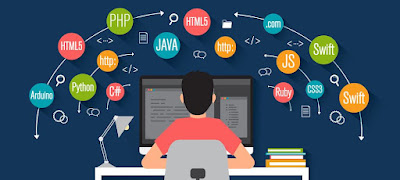- Get link
- Other Apps
Creating a comprehensive list of all programming languages from the beginning of computer programming to the present day would be quite extensive and beyond the scope of a single response. However, I can provide an overview of some significant programming languages that have played key roles in the history and development of computing:
Assembly Language: Developed in the 1940s, assembly language is a low-level programming language that directly corresponds to machine code instructions. It was used for early computer programming and remains important for system-level programming.
Fortran (1957): Fortran, short for Formula Translation, was one of the earliest high-level programming languages designed for scientific and engineering computations.
Lisp (1958): Lisp, short for LISt Processing, is one of the oldest high-level programming languages. It is known for its unique syntax based on symbolic expressions and its use in artificial intelligence research.
COBOL (1959): COBOL, short for COmmon Business-Oriented Language, was developed for business, finance, and administrative systems. It remains in use today in legacy systems.
ALGOL (1958-1960): ALGOL, short for ALGOrithmic Language, was one of the earliest structured programming languages and influenced the development of many subsequent languages.
BASIC (1964): Beginner's All-purpose Symbolic Instruction Code (BASIC) was designed to make programming more accessible to beginners. It became popular for educational and personal computer programming.
C (1972): C is a general-purpose programming language developed by Dennis Ritchie at Bell Labs. It has had a profound influence on the development of many other programming languages and operating systems.
Pascal (1970s): Pascal was developed as a language suitable for teaching programming and for writing system software.
Smalltalk (1970s): Smalltalk is an object-oriented programming language known for its innovative features, including a highly dynamic runtime environment and graphical user interface development tools.
C++ (1983): C++ is an extension of the C programming language with support for object-oriented programming. It has become widely used for developing system software, game engines, and applications.
Perl (1987): Perl is a high-level, interpreted programming language known for its text processing capabilities and practicality for system administration tasks.
Python (1991): Python is a high-level, interpreted programming language known for its simplicity and readability. It has become popular for web development, data analysis, artificial intelligence, and more.
Java (1995): Java is a general-purpose programming language designed to be platform-independent. It is widely used for building enterprise software, mobile applications, and web services.
JavaScript (1995): JavaScript is a scripting language primarily used for web development. It enables interactive and dynamic functionality within web browsers.
Ruby (1995): Ruby is a dynamic, object-oriented programming language known for its simplicity and productivity. It is often used for web development and scripting.
C# (2000): C# (pronounced as "C sharp") is a modern, object-oriented programming language developed by Microsoft. It is widely used for building Windows applications, web services, and games.
Swift (2014): Swift is a programming language developed by Apple for building iOS, macOS, watchOS, and tvOS applications. It is designed to be safe, fast, and expressive.
This list represents only a fraction of the many programming languages that have been developed over the years. Each language has its own unique features, strengths, and areas of application, contributing to the rich and diverse landscape of programming.
